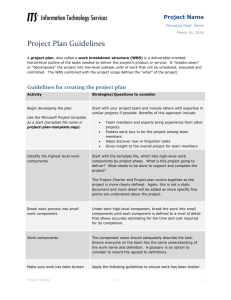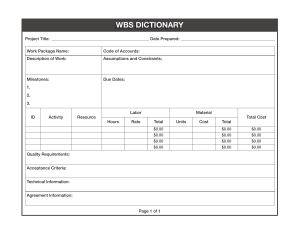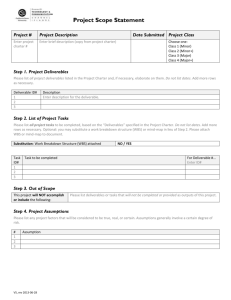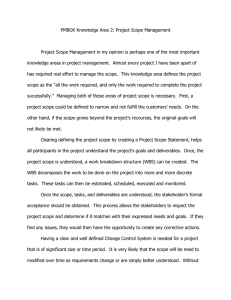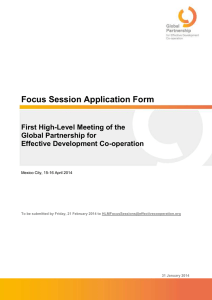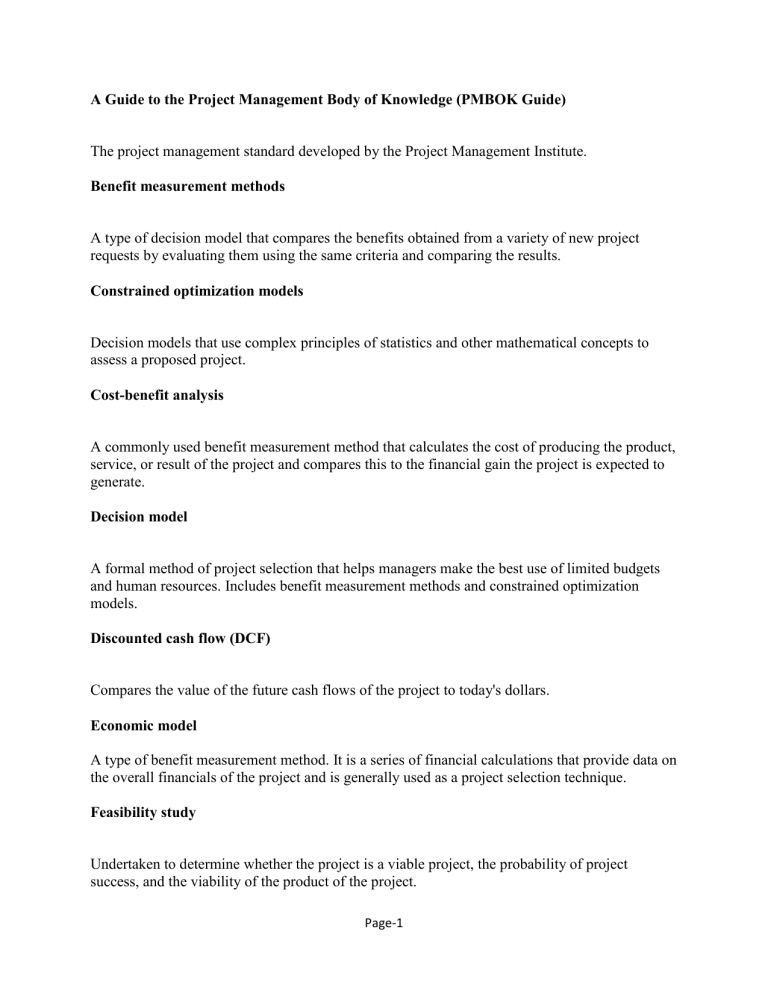
A Guide to the Project Management Body of Knowledge (PMBOK Guide) The project management standard developed by the Project Management Institute. Benefit measurement methods A type of decision model that compares the benefits obtained from a variety of new project requests by evaluating them using the same criteria and comparing the results. Constrained optimization models Decision models that use complex principles of statistics and other mathematical concepts to assess a proposed project. Cost-benefit analysis A commonly used benefit measurement method that calculates the cost of producing the product, service, or result of the project and compares this to the financial gain the project is expected to generate. Decision model A formal method of project selection that helps managers make the best use of limited budgets and human resources. Includes benefit measurement methods and constrained optimization models. Discounted cash flow (DCF) Compares the value of the future cash flows of the project to today's dollars. Economic model A type of benefit measurement method. It is a series of financial calculations that provide data on the overall financials of the project and is generally used as a project selection technique. Feasibility study Undertaken to determine whether the project is a viable project, the probability of project success, and the viability of the product of the project. Page-1 Functional organization A form of organizational structure. Functional organizations are traditional organizations with hierarchical reporting structures. Internal rate of return (IRR) The discount rate when the present value of the cash inflows equals the original investment. Projects with higher IRR values are generally considered better than projects with lower IRR values. Assumes that cash inflows are reinvested at the IRR value. Matrix organization An organizational structure where employees report to one functional manager and at least one project manager. Functional managers assign employees to projects and carry out administrative duties, while project managers assign tasks associated with the project to team members and execute the project. Net present value (NPV) Evaluation of the cash inflows using the discounted cash flow technique, which is applied to each period the inflows are expected. NPV subtracts the initial project investment from the total cash flow in today's dollars. It is similar to discounted cash flows. Operations Operations typically involve ongoing functions that support the production of goods or services. They don't have a beginning or an end. Payback period The length of time it takes a company to recover the initial cost of producing the product or service of the project. Program A grouping of related projects that are managed together to capitalize on benefits that couldn't be achieved if the projects were managed separately. Page-2 Project Temporary in nature, with a definite start and end date; creates a unique product, service, or result. It is completed when the goals and objectives of the project have been met and signed off on by the stakeholders. Project justification Documentation in the project charter that includes the reason the project is being undertaken and the business need the project will address. Project management Applying skills, knowledge, and project management tools and techniques to fulfill the project requirements. Project Management Institute (PMI) The world's leading professional project management association. Project management office (PMO) Established by organizations to create and maintain procedures and standards for project management methodologies to be used throughout the organization. Project manager The person responsible for applying the skills, knowledge, and project management tools and techniques to the project activities to successfully complete the project objectives. Project plan A document, or assortment of documents, that constitutes what the project is, what the project will deliver, and how all the processes will be managed. Used as the guideline throughout the project Executing and Controlling phases to track and measure project performance and to make future project decisions. Also used as a communication and information tool for stakeholders, team members, and management. Page-3 Project selection Used to determine which proposed projects are approved to move forward. Scoring model One of the benefit measurement methods used for project selection. It contains a predefined list of criteria against which each project is ranked. Each criterion has a scoring range and a weighting factor. A scoring model can also be used as a tool to select from among competing vendors. Project stakeholders are anyone who has a vested interest in the outcomes of the project. Some project stakeholders you will likely encounter include the project sponsor, team members, functional managers, and customers (both internal and external). A project sponsor is an executive in the organization who has the authority to assign budget and resources to the project. Project sponsors serve as the final decision-makers on the project, sign and approve the project charter, and remove obstacles so the team can perform their work. Project sponsors often act as the project champions as well. They spread enthusiasm for the project and act as cheerleaders regarding its benefits. The project coordinator assists the project manager with administrative functions. The project scheduler coordinates and updates the project schedule and keeps stakeholders informed of schedule progress. The project manager is responsible for coordinating and managing the project team, communications, scope, risk, budget, and time. They also manage quality assurance and are responsible for the project artifacts. A PMO provides guidelines, templates, and processes for managing the project. The project request process starts with a high-level scope definition that describes the project objectives, the high-level deliverables, and the reason for the project. It also describes the relationship between the business need and the product or service requested. Be able to define a project manager. The project manager manages the team, communication, scope, risk, budget, and time. They also manage quality assurance and are responsible for the project artifacts. Be able to define a project sponsor. A project sponsor is an executive in the organization who has the authority to allocate dollars and resources to the project. The sponsor approves funding, the project charter, the project baseline, and high-level requirements. They have final decision-making authority for the project, help with marketing the benefits of the project, remove roadblocks for the team, and participate in business case justification. Page-4 Be able to define project stakeholders. A stakeholder is anyone who has a vested interest in the project and has something to gain or lose from the project. Stakeholders include the sponsor, project manager, project team members, functional managers, customers, team members, and others with an interest in the project. Be able to define a project coordinator. Project coordinators assist the project manager with cross-functional coordination, documentation, administrative support, time and resource scheduling, and quality checks. Be able to define a scheduler. The scheduler is responsible for developing and maintaining the project schedule, communicating timeline and changes, reporting on schedule performance, and obtaining the status of work performed from team members. Be able to define the project team. The project team contributes expertise to the project, works on deliverables according to the schedule, estimates task durations, estimates costs, and estimates dependencies. Be able to define the project management office. The PMO provides guidance to project managers and helps present a consistent, reliable approach to managing projects across the organization. PMOs are responsible for maintaining standards, processes, procedures, and templates. Customer The recipient of the product or service created by the project. In some organizations this stakeholder may also be referred to as the client. Project champion The person who fully understands, believes in, and espouses the benefits of the project to the organization. This is the cheerleader for the project. Sponsor An executive in the organization with authority to allocate funds, assign resources, and enforce decisions regarding the project. Stakeholder A person or an organization that has something to gain or lose as a result of the project. Most stakeholders have a vested interest in the outcomes of the project. After your meeting with Kate, you start writing the project charter. Here is a rough draft outline of that document for the Main Street Office Move: Page-5 Purpose for the Project: To bring together all employees into one building. This will improve communication, reduce travel costs, improve productivity, and reduce lease costs. Project Goals: This project will relocate 1,200 employees from three locations to the Main Street Office Building location. The move will be completed by December 31. All employees will report to work on January 2 at the Main Street Office Building. Project Description: Relocate 1,200 employees to one location at the Main Street Office Building. The move is planned over the holiday period so that it's as minimally disruptive as possible. All employees have the period from December 25 to January 1 as paid time off. All employees will pack their personal belongings and take with them when they leave for the holiday period. All work-related items will be packed before leaving the evening of December 24. Key Deliverables: Communication to all employees regarding the purpose for the move and instructions regarding packing belongings, location of new office, and timelines. Communication should occur in multiple forms at least five times before the move. Procure the services of a moving company to move boxes and furniture. Procurement process to start six months prior to the move date. Survey the Main Street Office Building and work with functional managers to determine seating charts. Procure new office furniture. Delivery and setup take place between December 26 and December 31. High-Level Requirements: Communication methods include all-hands meetings at each existing office location to explain the move. Establish a wiki site on the intranet with details as they become available. The moving company chosen to perform this move will have experience in relocating offices. All furniture will conform to the chosen color and pattern theme. High-Level Milestones: o Communication to employees completed. o Moving company procurement completed. o Seating charts approved and finalized. o New furniture delivered and placed by December 31. o Office 1 move completed. o Office 2 move completed. o Office 3 move completed. High-Level Budget: The total budget for this project is $450,000. High-Level Assumptions: o Employees are supportive of the move. o Moving companies are available during the move week. o Employees will have personal belongings packed and removed from premises prior to move. o Furniture is delivered on time. High-Level Constraints: o December 31 completion date. o $450,000 budget. High-level Risks: Bad weather during the move week. Page-6 Name of the Project Manager: You. Your authority level consists of managing the budget, expending funds to perform the work, requesting resources to assist you, and contracting with a moving company for services. Criteria for Project Approval: The project will be considered successful when all three offices are relocated by December 31 and it stays within the $450,000 budget. Assumption An event or action believed to be true for planning purposes. Project assumptions should always be documented. Closing Executing High-level requirements Initiating Milestone Monitoring and Controlling Planning Project charter A process that documents the final delivery and acceptance of the project and is where hand-off occurs to the operational unit. Lessons learned are performed during this process, and project team members are released. This project process group is where the work of the project is performed. These explain the major characteristics of the product and describe the relationship between the business need and the product requested. This is also referred to as a product description. The first process in a project life cycle and the first of the five project process groups. This is the formal acknowledgment that the project should begin. The primary result of this process is the project charter. A major deliverable or key event in the project used to measure project progress. This project process group is where activities are performed to monitor the progress of the project and determine whether there are variances from the project plan. Corrective actions are taken during this process to get the project back on course. The process group where the project plans are developed that will be used throughout the project to direct, monitor, and control work results. The primary result of this process is the project plan. Page-7 An official, written acknowledgment and recognition that a project exists. It's signed by the project sponsor and gives the project manager authority to assign organizational resources to the work of the project. Project description Scope Acceptance criteria Business requirements Constraint Decomposition Deliverable Key performance indicators (KPIs) Order of magnitude Scope management plan Documents the key characteristics of the product or service that will be created by the project. The description of the work involved to complete the project. It defines both what is included in the project and what is excluded from the project. The process and the criteria that will be used to determine whether the deliverables are acceptable and satisfactory. The requirements that describe how the business objectives of the project will be met. Anything that either restricts the actions of the project team or dictates the actions of the project team. The process of breaking project deliverables down into smaller, manageable components of work so that work packages can be planned and estimated. An output or result that must be completed in order to consider the project complete or to move forward to the next phase of the project. Deliverables are tangible and can be measured and easily proved. Help you determine whether the project is on track and progressing as planned by monitoring the project against predetermined criteria. A high-level estimate of the time and cost of a project based on the actual cost and duration of a similar project. Page-8 Defines the process for preparing the scope statement and the WBS. This also documents the process that manages project scope and changes to project scope. Scope planning Scope statement Work breakdown structure (WBS) Work breakdown structure (WBS) dictionary Work package 1.6 Given a scenario, execute and develop project schedules. o Scheduling activities Determine tasks Determine task start/finish dates Determine activity/task durations Determine milestones Set predecessors Set dependencies Sequence tasks Prioritize tasks Determine critical path Allocate resources Set baseline Set quality gates Set governance gates Client sign off The process of defining the scope management plan, the scope statement, and the WBS and WBS dictionary. Documents the product description, key deliverables, success and acceptance criteria, key performance indicators, exclusions, assumptions, and constraints. The scope statement is used as a baseline for future project decisions. A deliverable-oriented hierarchy that defines the total work of the project. Each level has more detailed information than the previous level. A document that describes the deliverables and their components, the code of accounts identifier, estimates, resources, criteria for acceptance, and any other information that helps clarify the deliverables. The lowest level in a WBS. Team assignments, time estimates, and cost estimates can be made at this level. On very large projects, this level is handed off to subproject managers who develop their own WBS to fulfill the requirements of the work package deliverable. Page-9 Management approval Legislative approval 4.1 Compare and contrast various project management tools. o Project Scheduling Software o Charts Gantt chart Activity duration Assessing the number of work periods needed to complete the project activities. Work periods are usually expressed in hours or days. Large projects might express duration in weeks or months. Activity list Analogous estimating Crashing Critical path (CP) Critical path method (CPM) Dependencies Dependency relationships A list of all the activities required to complete the work of the project that also includes an identifier code and the WBS code it's associated with. Activities are broken down from the work package level of the WBS. An estimating technique that uses the actual duration of a similar, completed activity to determine the duration of the current activity. This is also called top-down estimating. This is a schedule compression technique that adds resources to the project to reduce the time it takes to complete the project. The longest path through the project. Activities with zero float are considered critical path tasks. A schedule development method that determines a single early and late start date, early and late finish date, and the float for each activity on the project. The relationship between project activities. The type of dependency between two activities and the specific relationship between the activities. Page-10 Duration compression External dependency Fast-tracking Finish-to-finish Finish-to-start Float time Logical relationships Mandatory dependency Network diagram Precedence diagramming method (PDM) The use of techniques such as fast-tracking or crashing to shorten the planned duration of a project or to resolve schedule slippage. A type of dependency where a relationship between a project task and a factor outside the project, such as weather conditions, drives the scheduling of that task. A schedule compression technique where two activities that were previously scheduled to start sequentially start at the same time. Fast-tracking reduces schedule duration. A project task relationship in which the finish of the successor task is dependent on the finish of the predecessor task. A project task relationship in which the successor task cannot begin until the predecessor task has completed. The amount of time the early start of a task may be delayed without delaying the finish date of the project. Also known as slack time. The dependency relationships that may exist between tasks. Finish-to-start is the most common logical relationship. A type of dependency where the relationship between two tasks is created by the type of work the project requires. A depiction of project activities and the interrelationships between these activities. A network diagramming method that places activities on nodes, which connect to dependent activities using arrows. Also known as activity on node. Page-11 Program evaluation and review technique (PERT) Schedule baseline Start-to-finish Start-to-start Calculates the expected value, or weighted average, of critical path tasks to determine project duration by using three estimates: most likely, pessimistic, and optimistic. The PERT calculation is (optimistic + pessimistic + (4 × most likely)) / 6. The final, approved project schedule that is used during project execution to monitor project progress. A task relationship where the finish of the successor task is dependent on the start of its predecessor. A project task relationship where the start of the successor task depends on the start of the predecessor task. Calculating the three-point estimate is straightforward. It's an average of the sum of the estimates. For example, let's say your most likely estimate is $120 per hour. The optimistic estimate is $110 per hour, and the pessimistic estimate is $150 per hour. The three-point estimate is calculated this way: ($120+$110+$150)/3=$126.67 (\$120+ \$110+ \$150) / 3= $126.67\; per\; hour($120+$110+$150)/3=$126.67perhour Know the difference between analogous, parametric, and bottom-up estimating techniques. Analogous, or top-down, estimates use expert judgment and historical data to provide a high-level estimate for the entire project, a phase of the project, or a deliverable. Parametric estimates use a mathematical model to create the estimates. The bottom-up method starts at the lowest level of the WBS and calculates the cost of each item within the work packages to obtain a total cost for the project or deliverable. Name the two discretionary funding allocations a project may receive. The two types of discretionary funding are a contingency reserve and a management reserve. Contingency reserves are monies set aside to cover the cost of possible adverse events. Management reserves are set aside by upper management and are used to cover future situations that can't be predicted during project planning. Page-12 Explain the purpose of a cost baseline. The cost baseline is the total approved, expected cost for the project. It's used in the Executing and Monitoring and Controlling processes to monitor the performance of the project budget throughout the project. Explain the risk identification process. Risk identification is the process of identifying and documenting the potential risk events that may occur on the project. Explain the purpose of risk analysis. Risk analysis evaluates the severity of the impact to the project and the probability that the risk will actually occur. Explain the purpose of risk response planning. Risk response planning is the process of reviewing the list of potential risks impacting the project to determine what, if any, action should be taken and then documenting it in a response plan. Name the negative risk response strategies. The negative risk response strategies are avoid, transfer, mitigate, and accept. Name the positive risk response strategies. The positive risk response strategies are exploit, share, enhance, and accept. Actual cost (AC) Bottom-up estimating Contingency reserve Cost baseline Cost budgeting The cost to complete a component of work in a given time period. Actual costs include direct and indirect costs. Individually estimating each work package, all of which are then rolled up, or added together, to come up with a total project estimate. This is a very accurate means of estimating, provided the estimates at the work package level are accurate. An amount of money or time set aside and dedicated to the project to be used to cover unforeseen costs or time that was not identified as part of the planning process. The total approved, expected cost of the project created in the planning process. It's used as a comparison to actual project expenses throughout the remainder of the project. Page-13 Assigning cost estimates to activities and creating the cost baseline, which measures the performance of the project throughout the project's life. Cost estimating Cost performance index (CPI) Cost variance Earned value (EV) Impact Managerial reserve Planned value (PV) Probability Risk Risk analysis Risk identification Developing an estimation of the cost of resources needed for each project activity. Measures the value of the work completed at the measurement date against actual cost. This is the most critical of all EVM measurements. The formula is CPI = EV / AC. The difference between a task's value at the measurement date and its actual cost. The formula is CV = EV – AC. The value of the work completed to date as it compares to the budgeted amount for the work component. The consequences imposed if a risk event occurs on the project. An amount of money set aside by upper management to cover future expenses that can't be predicted during project planning. The cost of work that's been budgeted for an activity during a certain time period. The likelihood a risk event will occur. Probability is expressed as a number between 0.0 and 1.0. A potential future event that can have either negative or positive consequences. The process used to identify and focus on those risks that are the most critical to the success of your project. Page-14 Identifying the potential project risks and documenting their characteristics. Risk list Schedule performance index (SPI) Schedule variance (SV) Work effort A numbered list of risks that are produced during the risk identification process and that are documented within a risk register. Measures the progress to date against the progress that was planned. The SPI indicator acts as an efficiency rating. If the result is greater than one, performance is better than expected, and you're ahead of schedule. If it's less than one, performance is less than expected, and you're behind schedule. The formula is SPI = EV / PV. The difference between a task's progress as compared to its estimated progress represented in terms of cost. The formula is SV = EV − PV. The total time it takes for a person to complete a task if they did nothing else from the time they started until the task was complete. Page-15
